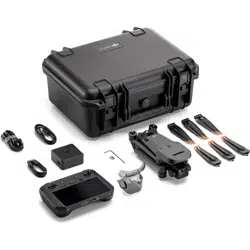Loading ...
Loading ...
Loading ...

13
©
2022 DJI All Rights Reserved.
Flight Safety
Make sure to have training and practice before operating any actual flight. Practice with
the simulator in DJI Assistant 2 or fly under the guidance of experienced professionals. Pick
a suitable area to fly in according to the following flight requirements and restrictions. Fly
the aircraft below 120 m (400 ft). Any flight altitude higher than that may violate local laws
and regulations. Make sure you understand and comply with the local laws and regulations
before flying. Read the Safety Guidelines carefully to understand all safety precautions
before flying.
Flight Environment Requirements
1. DO NOT operate the aircraft in severe weather conditions, including wind speeds
exceeding 12 m/s, snow, rain, and fog.
2. Only fly in open areas. Tall buildings and large metal structures may affect the accuracy
of the onboard compass and GNSS system. It is recommended to keep the aircraft at
least 5 m away from structures.
3. Avoid obstacles, crowds, trees, and bodies of water (recommended height is at least 3 m
above water).
4. Minimize interference by avoiding areas with high levels of electromagnetism, such
as locations near power lines, base stations, electrical substations, and broadcasting
towers.
5. DO NOT take off from an altitude more than 6,000 m (19,685 ft) above sea level. The
performance of the aircraft and its battery is limited when flying at high altitudes. Fly
with caution.
6. GNSS cannot be used on the aircraft in polar regions. Use the vision system instead.
7. DO NOT take off from moving objects, such as cars and ships.
8. Make sure the beacon and the auxiliary bottom light are enabled at night for flight
safety.
9. To avoid affecting the motor service life, DO NOT take off or land the aircraft on sandy
or dusty areas.
Wireless Communication Requirements
1. Fly in wide open areas. Tall buildings, steel structures, mountains, rocks, or tall trees
may affect the accuracy of the GNSS and block the video transmission signal.
2. Avoid interference between the remote controller and other wireless equipment. Make
sure to power off nearby Wi-Fi and Bluetooth devices when controlling the aircraft by
remote control.
3. Be extremely alert when flying near areas with magnetic or radio interference. Pay close
attention to the image transmission quality and signal strength on DJI Pilot 2. Sources
of electromagnetic interference include but are not limited to: high voltage lines, large-
Loading ...
Loading ...
Loading ...
